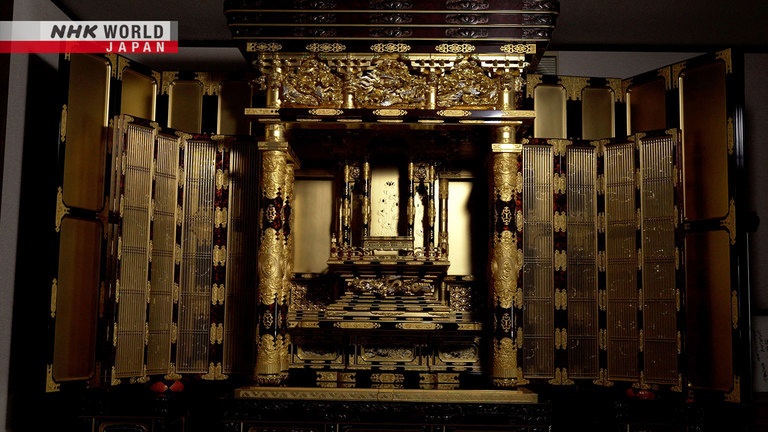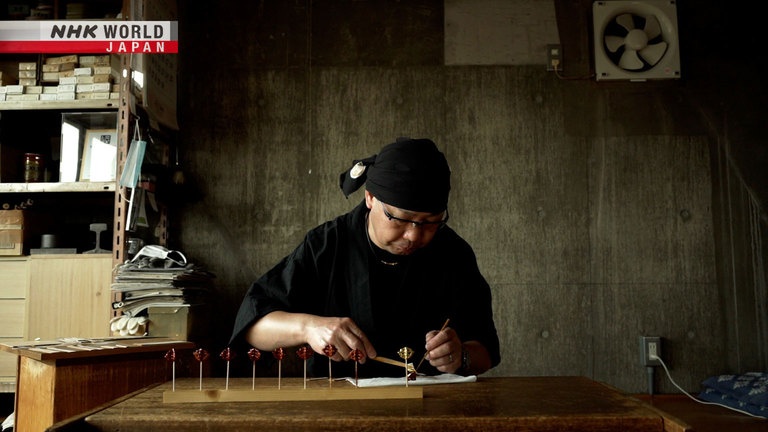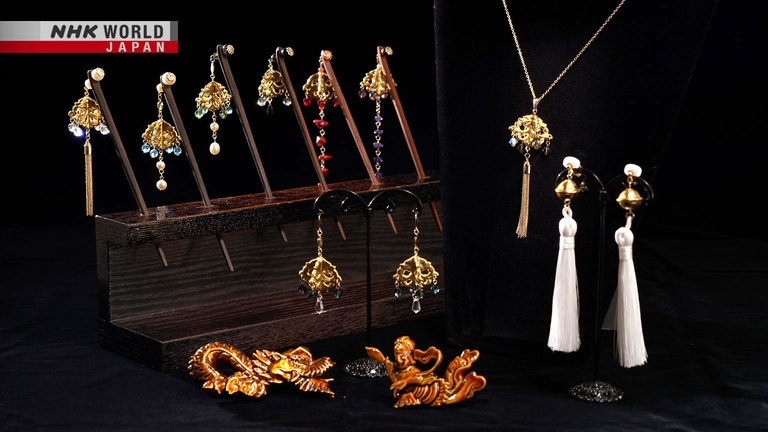Altar Accessories
Many Japanese homes have beautifully decorated altars called "butsudan" where families pray to Buddha and their ancestors. Their construction involves several traditional crafts. But with changes in Japanese lifestyles, they're now less common. An artisan who makes them, Nakazawa Yukihiro, is repurposing techniques used in their production to turn discarded altars into accessories. Working with his family, he's found a new way to use his skills and preserve a piece of this Japanese tradition.



Transcript
Since ancient times, the Japanese have believed that a life force resides in all creations.
Valuing and caring for the things we use, a "Zero Waste Life."
Pointing the way to better living for a new era.
It doesn't just end here.
I put everything into what I do.
So, say 30 or 50 years in the future
maybe they'll say, "he did amazing work."
Japanese have long prayed to Buddha and the spirits of their ancestors to watch over their families.
And small altars for this purpose called "butsudan" are even found in private homes.
They are a representation of heaven.
Traditional techniques such as delicate carving, application of gold leaf and lacquer work are used in abundance.
As a link to deceased loved ones, the "butsudan," is the heart of many Japanese homes.
Nakazawa Yukihiro of Nagoya makes and repairs them.
They aren't made by just one person.
They're the culmination of much expertise.
Shaping the wood, applying the lacquer,
and then the gilding on top of that.
The process involves multiple artisans.
Nakazawa's particular specialization is a classical technique known as "Hakuoshi," or Foil stamping.
Gold leaf one-ten thousandth of a millimeter thick, applied seamlessly to the lacquered surface.
Over his 40-year-plus career, he's worked on many such altars.
But he's currently faced with a problem.
This warehouse is full of altars
that are no longer wanted.
Japanese lifestyles and families have changed, and fewer homes have an altar.
Nakazawa is getting more and more requests for altar disposal.
They're all made by hand piece by piece.
It feels like such a waste
to throw this or that away.
Are they something the world wants?
What we wear, cars, homes even,
it takes all we have to keep up, maybe that's why they get thrown out.
There must be some use for them.
This thinking inspired Nakazawa to try something new.
Ornaments, or talismans, "yoraku, "
are used to decorate the altars.
Re-applying gold leaf and making modifications to their appearance, he reshapes them into fashion accessories.
First, they're carefully washed and polished.
Before adding gold leaf, dark brown resin is applied as a base.
This helps the gold layer shine even more brightly.
One of the many traditional techniques in Nakazawa's tool kit.
They've been in altars
for 50 or 60 years.
I give them new life, new sparkle.
It's what they deserve.
The gold shines through.
He uses a special brush to remove excess gold leaf.
The gold dust that falls off in the process is also used, filling in any areas that aren't fully covered.
These altar ornaments, once set for destruction, are soon to be reborn.
Now, with the help of his family, the assembly process begins.
Nakazawa's wife Yumi, in order to compliment the ornaments that he has delicately gilded, chooses suitable beads.
I've always liked making jewelry.
Accessories seemed like a good idea
as a project for my husband.
Tiny 5mm beads.
Their daughter, Ikumi, prepares them for application.
When I was really little I found
some scraps in dad's workshop.
- I brought them home, right?
- Yes, you did.
I guess it looked like jewelry to me.
It's pretty amazing to me that
now we're actually making jewelry, giving new life to these ornaments.
A finished pair of altar ornament earrings.
Although they look heavy, they actually weigh just three grams since the original material was so light.
They're made to be gentle on the ears of the wearer.
And here's a matching necklace.
These traditional hair ornaments called "kanzashi" are made with wood from the altars.
They also repurpose other decorative elements into items like these lacquered broaches.
Treasures born of traditional technique and the power of family.
Their son Ryusuke, who normally works assembling industrial machine tools, seems to have taken a liking to his father's work.
Honestly, dad's work never interested me.
It seemed too difficult, but now
it's become more appealing to me.
Dad applies the gold leaf on his own,
and so I'd like to help with that.
That way, both of us can do it.
All it takes is hard work.
They take the finished accessories to a craft fair.
Intricately made items of the finest quality featuring real gold leaf, they sell for around $150 US dollars.
Their brilliance attracts one customer after another.
Wow, they're so light!
- Everyone thinks they'll be heavy.
- It's quite a surprise.
"- How do you feel about reusing altars? "
- It's really interesting, quite a blessing.
You don't often see things like these.
I'm pretty impressed they came up with it.
They're a hit with those looking for something a bit different.
- Nice sale!
- Thank you very much.
Seeing people actually buy them
makes it feel worth all the effort.
Buddhist altars linking families and ancestors.
Increasingly discarded, they can still have a role to play as cherished accessories.
This is Nakazawa's way of thinking.
Keeping the altars is the ideal.
But say your parents die
and you have to sell their home.
So, you dispose of the altar.
This way, you know a piece of it
remains as a sort of memorial.
This is what I hope to create.